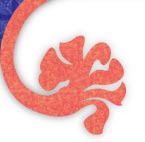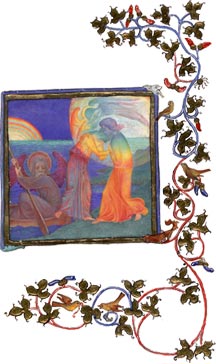A commentary by Elizabeth Cumming
The National Library of Scotland's copy of the Victorian poet Elizabeth Barrett Browning's 'Sonnets from the Portuguese' is a key Arts and Crafts illuminated manuscript. It was made by Phoebe Anna Traquair HRSA (1852-1936) in Edinburgh between 1892 and January 1897.
Individual designs
Elizabeth Barrett Browning's sonnets, written in 1850, express an emotional journey and the growth of love. Traquair responded to each sonnet individually, working through them in strict order and completing, dating and signing each one with her customary monogram PAT before starting the next.
Traquair used inks, watercolours and gold leaf on 46 individual vellum pages, each one measuring 18.6 by 14.8 cm. She first designed a principal image for each page, sketching it in advance and experimenting with form and especially colour. The illuminated initial was painted before the text of the sonnet was written in. Pages were then completed with various decorative motifs, many of which are influenced by 14th-century European, and especially Italian, manuscripts.
Inspiration
Throughout the manuscript, as elsewhere in her art, Traquair drew on a wide range of ideas from the visionary illuminated books of Blake to Pre-Raphaelite romance and the realist paintings of the late Victorian age. She included portraits of both Robert Browning and Elizabeth Barrett Browning (see sonnet 26). Every page is the collective product of her inspiration and imagination, and has an intensity of emotion which reflects both the power and development of Elizabeth Barrett Browning's narrative.
Pre-eminent illuminator
Traquair exhibited finished unbound pages in April 1895 in an Arts and Crafts exhibition in the Queen's Rooms, Glasgow. When the entire manuscript was complete, she was interviewed by Margaret Armour, Edinburgh correspondent of the London journal 'The Studio', who referred to Traquair and Swiss illuminator Edmond Reuter as 'pre-eminent' in the field.
In 'Beautiful Modern Manuscripts' in 'The Studio' Special Winter Number for 1897, Armour illustrated four pages from this manuscript and quoted Traquair as praising 13th- and 14th-century illuminated work, where 'the smallness of the work [makes] it all the more necessary for the worker to limit himself to the vital points with a stern negation of non-essentials: all decorative art, of which illumination is but a department, being in its very nature an accompaniment, as an instrument is to the voice.'
Experimental colour
Identifying connections between music and art, Traquair enjoyed the lyrical values of colour. Purple and gold were particularly 'delightful things to play with'. In this manuscript and 'The House of Life', her use of colour became experimental. She used 'pure transparent colour' with some hatching of yellow and blue for green. Additionally, in a microscopic, almost neo-impressionist, manner, she also placed 'particles' of pure colour side by side. These two manuscripts for her brother thus bring together modern art with an appreciation of the ideas and values of tradition.
Additional copy
By late 1897 Traquair would be a member of a collective of women binders who met regularly in the Dean Studio in Edinburgh's west end and were to exhibit in Edinburgh and London.
Although this exquisite manuscript was in fact bound by the Doves Press, several copies of a limited photographic edition published by William Hay of Edinburgh were to be worked 'blind' in her typical figurative style. She worked a similar morocco binding for a duplicate copy (1895-7) of 'Sonnets from the Portuguese' for Lady de Vesci. A number of additional duplicate individual pages are also known (National Gallery of Scotland, private collections).



